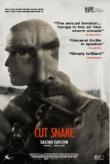AustLit
Latest Issues
AbstractHistoryArchive Description
'Set in the mid-1970s, Cut Snake tells the story of twenty-something Sparra Farrell, a very private man who is trying to start a new life in Melbourne. He has found honest work and becomes engaged to the beautiful Paula. But his past catches up with him and threatens his new life when the charismatic Pommie tracks him down. Sparra finds himself sucked back into a world that he thought he had left behind.' (Source: SBS website)
Publication Details of Only Known VersionEarliest 2 Known Versions of
Works about this Work
-
Gender and Sexual Diversity and Suicide on Australian Screens : Culture, Representation, and Health Pedagogies
2021
single work
criticism
— Appears in: Journal of Popular Culture , April vol. 54 no. 2 2021; (p. 365-387)'Despite an often‐repeated cliché that gender and sexually diverse characters are relatively absent from film and television, Australian screen production has a very rich history of representing sexual and gender diversity: greater than nineteen wide‐release films since 1993, including internationally recognized films such as Priscilla, Queen of the Desert (1994), The Sum of Us (1994), Head On (1998), and The Monkey’s Mask (2000), portray gender and sexual diversity. Nine Australian films with LGBTQ, gender, and sexually diverse themes were released between 2013 and 2018, indicating an entrenchment of LGBTQ representation on Australian screens. Characters in major Australian television dramas and soap operas, such as Home and Away and Neighbours, have increased in regularity and complexity over the past two decades. Sexual stories, including narratives of minority sexual lives, have never, of course, been repressed or invisible, but according to Ken Plummer, they have long been central to contemporary Western culture (4). Stories representing gender and sexually diverse subjects depicting identity struggles and articulating minority health outcomes are a major and ongoing part of Australian creative production. What is significant in cultural analysis is not questions of visibility or invisibility but how the continuities and disruptions of depictions of gender and sexual minorities play a significant, pedagogical role in social participation, social harmony, acceptance, individual health and wellbeing, and community belonging (Cover, Queer Youth Suicide; Emergent Identities).' (Introduction)
-
Living in the '70s
2015
single work
review
— Appears in: The Courier-Mail , 10 October 2015; (p. 16)
— Review of Cut Snake 2014 single work film/TV -
[Review] Cut Snake
2015
single work
review
— Appears in: The Advertiser , 26 September 2015; (p. 30)
— Review of Cut Snake 2014 single work film/TV -
Not Your Damsel in Distress
2015
single work
column
— Appears in: The Advertiser , 1 October 2015; (p. 32) -
Rock On
2015
single work
review
— Appears in: The Adelaide Review , October no. 428 2015; (p. 29)
— Review of Cut Snake 2014 single work film/TV
-
Big, Bad and Homegrown
Riding the Homegrown Crime Wave
2014
single work
review
— Appears in: The Sydney Morning Herald , 23-24 August 2014; (p. 12-13) The Canberra Times , 23 August 2014; (p. 12) The Age , 23 August 2014; (p. 18)
— Review of Felony 2013 single work film/TV ; Cut Snake 2014 single work film/TV ; Son of a Gun 2013 single work film/TV ; Kill Me Three Times 2014 single work film/TV -
Sharp-Edged Tale Laced with Menace
2015
single work
review
— Appears in: The Sun-Herald , 20 September 2015; (p. 11)
— Review of Cut Snake 2014 single work film/TV -
Daring Love Triangle at Heart of Bold Home-grown Crime Caper
2015
single work
review
— Appears in: The Sydney Morning Herald , 24 September 2015; (p. 29)
— Review of Cut Snake 2014 single work film/TV -
Cut Snake Review – Another Creepily Charismatic Australian Screen Criminal
2015
single work
review
— Appears in: The Guardian Australia , 24 September 2015;
— Review of Cut Snake 2014 single work film/TV -
The Boy Is Back in Town
2015
single work
review
— Appears in: The Sydney Morning Herald , 25 September 2015; (p. 6)
— Review of Cut Snake 2014 single work film/TV -
Not Your Damsel in Distress
2015
single work
column
— Appears in: The Advertiser , 1 October 2015; (p. 32) -
Gender and Sexual Diversity and Suicide on Australian Screens : Culture, Representation, and Health Pedagogies
2021
single work
criticism
— Appears in: Journal of Popular Culture , April vol. 54 no. 2 2021; (p. 365-387)'Despite an often‐repeated cliché that gender and sexually diverse characters are relatively absent from film and television, Australian screen production has a very rich history of representing sexual and gender diversity: greater than nineteen wide‐release films since 1993, including internationally recognized films such as Priscilla, Queen of the Desert (1994), The Sum of Us (1994), Head On (1998), and The Monkey’s Mask (2000), portray gender and sexual diversity. Nine Australian films with LGBTQ, gender, and sexually diverse themes were released between 2013 and 2018, indicating an entrenchment of LGBTQ representation on Australian screens. Characters in major Australian television dramas and soap operas, such as Home and Away and Neighbours, have increased in regularity and complexity over the past two decades. Sexual stories, including narratives of minority sexual lives, have never, of course, been repressed or invisible, but according to Ken Plummer, they have long been central to contemporary Western culture (4). Stories representing gender and sexually diverse subjects depicting identity struggles and articulating minority health outcomes are a major and ongoing part of Australian creative production. What is significant in cultural analysis is not questions of visibility or invisibility but how the continuities and disruptions of depictions of gender and sexual minorities play a significant, pedagogical role in social participation, social harmony, acceptance, individual health and wellbeing, and community belonging (Cover, Queer Youth Suicide; Emergent Identities).' (Introduction)
Awards
- 2015 shortlisted Australian Academy of Cinema and Television Arts Awards — Best Original Screenplay
- 2014 shortlisted AWGIE Awards — Film Award — Original




